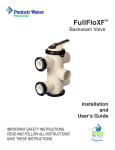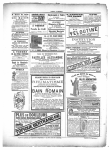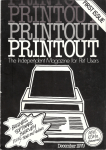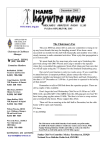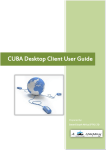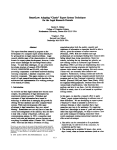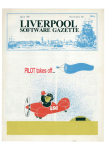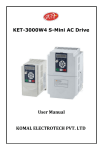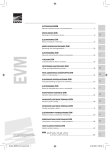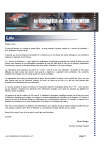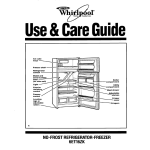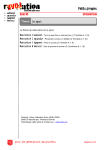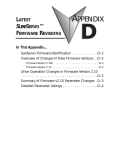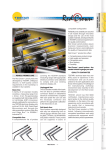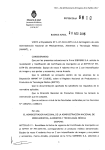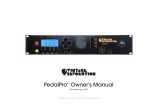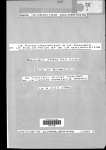Download iis. a-V s*
Transcript
iis. a-V s* COMMITTEE Vice Chairman: Pete Dowson General Secretary: Eli Pamphlett, Treasurer Luke Gardiner Software Librarian: Bob Wood Membership Enquiries: IPUG, 57 Clough Hall Road, Kidsgrove, Stoke-on Trent, Staffs. Assistant Editors: Mike Todd Ray Hunt Editor: Ron Geere, 109 York Road, Farnborough, Hants, G U M 6NQ. INDEPENDENT P E T USERS GROUP Vol. 3. No.2 •> * »■■!« i- -i- 'i- - f * -I- N e w sle tte r i- <• * * » » •»•* * -i * i- ;■ -i- * I- 1- -i- mar.1981 i- i i * * * * * ** Europe's first independent magazine for PET users * H«!• * fr-i-I !■ I- * Page l ■? ■! 1» 4--fr-i—fr * -i- * -i- v-i- -I- I- I- v ■i* *»*❖❖ C o nten ts 34 E d i t o r ' s N o te b o o .K 35 M a tte rs A r is in g 35 T ech T ip s 36 R e v ie w : 38 P e e k i n g &• P o k i n g About, HO C H C;c GQ '*0 S o ftw a re L ib ra ry R e v ie w : 2 5 3 2 EPROM P r o g r a m m e r A d d in io r.s The P ro g ra m m e r's F r ie n d 43 C o m m o d o re C o lu m n 4? D a ta P a c k in g 48 R e v ie w : 49 S h o p W in d o w 52 R e v ie w : S a le s L e d g e r P ackage TCL P a s c a l The o p in io n s expressed herein are those o f th e author and not necessarily those o f IPUG or the e d ito r Ite m s m e n tio n e d in "Shop W in d o w 'a r e c u lle d fro m a d v e r tis e rs m a te ria l and IPUG d o not necessarily endorse or recom m end such ite m s - caveat emplor 34 EDITOR'S .NOTEBOOK There art 1 5 number of 1980 b a c k - i s-aues of the Newsletter available (not the Compendium) for £1.00. Copies may be obtained by sendinq your remittance to IPUG, 57„ Clouqh Hall Read, Kidsqrove, Stoke-on-Trent, Staffs, ST7 1AR. I'1any dealers are prepared to offer favourable terms to IPUG members and for a runber of reasons, we have not leen able tc be too specific in print. Consequent ly some local qrcups have been able tc norce their own rr;nqenents with local cealers whi I ► -> others h-.ve been less fortunate. In order to extend the facility tc all members we are startinq a 'procurement' department run by Luke Gardiner and Rob Wood. Sob already supplies cassettes at a orice fruit would be difficult to match elsewhere, perhaps we can extend this to disks and also hardware. Some items such as printers have a 'price break-point of two or five. Let us know your requirement, we will find a orice. When requestea, you forward the money which ooes on tc tre dealer who then effects del'very. Warranty arrangements remain effective via the dealer. Contact Hob Wood at 13, Stow Iarid Crescent. Ward Green, Parrsley, South Yor*.s, S7H 5JS. In addition to the above we w til be shortly appointinc a publicity oft i cor to handle advertising, not only for dealers acs in tne Newsletter but to puulicise IPUG. Furth'i r on? nave we a member in the leqal profession who would be prepared to offer advice tc members on su'cn items as Sale of Goods Act, Warranties, leqal rights and the like. Confusion may have occurred when reoortina that the 1981 suiisc riot ion was unchanqec. I had in fact omitted tc mention tnat t.ie overseas subscription is ten oounds. P .D . tj. 0(5 O— 35 MATTERS ARISING Avid readers of this magazine will have noted the small print at the foot ot the contents paqe. so now to the Centronics 737 mentioned on p 9 . The claim that the 737 will do its own riqht-jus1 1 ficati on appears to be a misrepresentaion. It won't. In theory one can program the inter-letter spaces to produce a riqht-justify effect, but the printer will not do it without the appropriate software. In addition the solid character font only occurs in the 'proportional' spacinq mode - great except that any fornattinq or tabbing by the program is screwed up on printout. In the 'mono-spaced' mode, 10cpi qives similar print quality to most other matrix printers. The CBM Assembler requires the V symbol when declaring an address of a label in immediate mode when usinq the symbols '<' and ’ >' - two of the examples qiven in the manual g o not use a '#' symbol. David Pocock of CBM states that the GD001 assembler was renamed GD1100 some months after release. The 16K version mentioned in the manual was never released. 16K versions are now available toqether with the 32K version for 4000 and 8000 series machines. The 16K version is available to people who require it who can produce a letter from Hike Whitehead which was sent with early versions. Without this letter however, no free update is possible as the update is to cover only tr.e 16K version. — oOo— TECH TIPS H.M.H.Given writes that he cured a contact problem on a larqe-keyboard PET by carefully dismantling it and gently cleaning th< conducting rubber contacts. Unplug, unscrew and remove the keyboard entirely. Then „unsolder the shift-lock wires and unscrew the circuit boaro. Nothing leaps out anc you need not remove the keycaps. — oOo— 36 REVIEW °y Pay Hunt 2532 EPROM Programmer G.R.Etertromcs Have you ever considered locating your own machine code routines permanently within your PET ? - Yes ? - Well there exists a package to use your PET to program the 253? type EPROMs so that those pet (sorry) routines may be available on power up. The package consists of a small (16x5 cm' printed circuit board and a cassette which has been designed to run on old and new ROM machines. The printed circuit board plugs directly into tie back of the PET via all three of its edge ronnectors, taking data from the IEEE port, control signals from the user port, and ' power from the cassette port. These edge connectors are not reproduced on the back of the circuit board, out component arrangement on the board is well planned, with all the component locations suitably marked. A 24-pin d.i.l. socket is provided on board, to accomodate the EPROM which may be a master to be copied or a blank to be programmed. At extra expense a plinth mounted 'Zero Insertion For ce1 socket is available. This z.i.f. socket will ensure no damage is done to the EPROM during insertion or removal, and it also places the chip location adjacent to the PET's keyboard. The printed circuit board is uncased, the rear edge of the board being supported by pillars which conveniently rest on the flat surface which supports your PET. Only one control is provided here, an eight-contact d.i.l. switch which has the eight switch positions set according tc the type of EPROM in use. The software for the system is written in PET BASIC, with a number of machine code suoroutines for faster operation. When the program is loaded PET displays the required switch settings for each EPROM type, and when instructed takes 25 seconds to load the subroutines and display the menu. 37 The menu consists of 7 selections:0 BLOW PROM 1 READ PROM 2 FILL RAM 3 SEQUENCE IN RAM 4 VERIFY 5 PROM ERASED 6 READ/MODIFY/WRITE RAM In use, the system requires the 4K to 7K area of the PET's memory for the storage of data which is either read from a previously programmed EPROM or loaded from the keyboard using instruction '6'. Data is loaded in hexadecimal, and it is possible to add to, alter or increment without change any of the memory locations. It is also possible to load this memory area with a previously saved m/c program from cassette or disk before the circuit board is connected. In order to check if an EPROM is blank, instruction '5' is used, but as a precaution an automatic check is carried out every time instruction '0' is selected. PET takes 3 minutes 40 seconds to produce a fully programmed EPROM which if it is a '253?' will be pin-compatable with your PET's expansion sockets. While programming takes place your PET will count for you in octal ! - perhaps to keep you amused ? - (but more likely to let you know it has not forgotten what it should be doing). At the end of execution of any of the possible instructions the system is equally entertaining in that it generates a display of the graphics of the first 40 characters resident in RAM, along the bottom of the screen. Most of the system instructions are self evident, the least useful and most 'dangerous' are probably instructions '2' and '3'. Dangerous ? - Yes! - Selecting '2' or '3' when you have a full RAM erases it - forever ! The associated documentation may be described as sparse, but it contains sufficient information to enable the system to be exploited to the fullest extent. This documentation gives further indications of the ease with which it may be used:- 38 1. Selecting instruction '1' with no EPROM in the socket f i |! th'j memory area with 1 FF 1 , i.e. it clears the memory. 2. Although it is not possible to program 2K devices, it is still possible to read and verify them. Assuming that you understand a little about machine code programming it should take much less than an hour to become fully proficient with this EPROM programmer. (If you can write your own machine code then you can use this ?; s sm ) . In conclusion then, this unit is very well . .istructed, is relatively easy to use and the software contains no bugs to cause any problems. To make full use of t .is unit I believe that you may require an assembler which ! relocate your routines for ROM operation and at the time save a copy of the relocated code in RAM. if you're interested then you can get them from K. t-lect roni cs, Fairoak House, Church Road, Newport, '‘■'■nt. 2532 EPROM programmer - £92.00, Z.I.F. socket t h . .2r (inc VAT and postage). Note ! - a 2516/2716 rrjgrammer is also available. — oOo— PEEKING S POKING ABOUT Don't get caught as some do when 'shrinking' a program by removing spaces if the program contains IF ST AND 64 for example. Without spaces, PET sees it as IF S TAN D64 which l iOt what was intended. The cure is to use IF ST1 AND 64. .inc_ ST1 is stored as ST, it is interpreted as the status b t and the '1' prevents the TAN being seen. Ken Williams needed to know the duration of the Irv'.:. r-upt Service Routine (ISR), something believed to be r.' ^rto unpublished. His measurements come to a fraction o 1.5 milliseconds. Enthusiasts can wade through the c dc nd tot up the average number of machine cycles for i<--r » accuracy. — oOo— 39 The G R Electronics 2532/2732 PROM Programmer cc. i.e. C r r s ay 5th March the Stevenage District Amateur P u. o-ciety are holoing a computer m q h t and anyone with ! ome computer is invited to brinq it alcnq. It is hoped o have a wide selection of machines ranqinq from Nascoms ^ PETs ariu Apples. The meeting starts at Bom and is held in the staff canteen of British Aerospace Dynamics, °lant B, Gunnels Wood Road, Stevenaqe. If any IPUG members ere interested in attending they should contact Trevor ijqwell, G8KMV, 11, The Dell, Stevenaqe. Herts, SG1 1 PH or phone 0^38-54689. — oC o— NEW PET GROUP Following a recent meetinq of five local PET owners it was decided to form a local PET User Group covering the towns of Stevenage and Hitchin. If any owners of PET/CBM/VIC series of machines are interested in the club they should contact Phillip Mortiboy at the following address: 2 Spurrs Close. Hitchen, Herts, or phone Hitchen 54435. — oOo— SOFTWARE LIBRARY ADDITIONS 13. Assembler and Dis-assembI or (new ROMs only). Has most of the features found in professional assemblers now available, at a very low price. Some of the features are labels, variables, all addressing modes, cursor insert /de let e, supports 80-column printer (IEEE port only), and save assembler programs. 14. Concentration Game (ole ROMs only). A card game, which allows you to play against the computer, or other players. Full graphics on all 52 cards. 15. Aircraft Landing (old ROMs only). This program allows you to test your skill at landing an aircraft. 8 control variables are involved in controlling the aircraft. Full graphi cs. — oOo— 41 REVIEW The Pr oq rsm mer 1 s Friend ACT Petsoft £<;5.00 After selling over 6,000 'Toolkits' in 18 months. Chris Preston, Petsoft's chief programmer, has produced an upqreded version calleo the 'P r o g r a m m e r 's Friend'. Competition for the ROM slots has resulted in this version being disk-based, and excellent as this idea is, I cannot somehow reconcile it with their recent findings on illicit copying ! A perfunctory glance thrcuoh the handbook rr.ight suggest it is simply the Toolkit on disk, but closer examination reveals several notable improvements. Most of you are familiar with the Toolkit, even if you don't have one, and I make no apoloqies for comparing the two. AUTO is essentially the same, it provides line numbers in increments, either from parameter specified or by default from 100 in increments of 10. The subtle difference is that the Frienc will accept the default start value with a non-default increment, e.g AUTO .20. DELETE appears to be unchanged in deletinq a block of lines specified with parameters in the same format as LIST. DUMP, however, has a useful improvement. The Toolkit dumped the variable table tc the screen, scrolling being stopped with the SHIFT key, STOP aborting the routine. With the Friend, scrolling does not occur. The display waits at the bottom of the screen for a key press. The space bar clears the screen ono continues the dump; any other key aborts the rout ine. FIND is also unmodified in operation, with the exception of the same refinement as in DUMP of SPACE clearing the screen and continuing the display and STOP aborting the routine. In addition to printing the line containing the search key, the end character of the search key is displayed in reverse field. If the search key is a keyword, then the whole keyword is reversed. I was disappointed that only the first occurrence in a line was so displayed, for if one has, say, erroneously used a 42 sinqle variable for two co.iflictinq requirements ana wishes to chanqe some occurrences of X to Y, one could overlook an occurrence of X which had not been displayed in reverse f i °ld. HELP appears to be no different in use and f. esentation, but APPEND (which was cassette orientateci) hi been replaced by a true MERGE f ronr. disk. The format is t« .GE "PR0G2" TO ”1:PR0G1" for CBM disk drives, with PR0G2 fc ino on the default drive. I found the MERGE failed when .he "PR0G1" arive number was omitted. Lines in "PR0G1" replace line- of "PR0G2" havinc the same number. Renumber has been shortened to RENUM (althouqh as with all such keywords R with shifted~E will suffice) but the routine will now renumber a program block. REMUM a.b.c-d will renumber the block between tines c £• d starting at a in increments of b. Since the program tines are not resequenced, simply renumbered, you can have fun with this one, within the constraints of the error messages... Althouqh a thorc;rh evaluation takes time, I suspect that the Friend does not recoqnise the GO token, and this may affect FIND and REMUM if a split GO TO is used. TRACE anu STEP are still available but operation in the 'Friena' differs from the 'Toolkit'. The window which displays the executed line numbers, instead of scrolling the last six up, scrolls the last nine down. It took a lot of use to become accustomed to downward scrollinc. STEP to the next tine is by the SHIFT key. Either function can be disabled by the OFF command. So what's new ? Well BREAK sets abreakpoint at the specified line number. If in testinq you put a STOP in a program line, you can CONTinue. but if you need to remove it, CCNT produces CAN'T CONTINUE ERROR. With BREAK, it does not forr; part of your proqram, and it is cancelled after use. Additionally it can be cancelled with UMGRK. Also inherent in the 'Friend' is a repeat-key routine, active on all keys. Dwell time and repeat rate can be modified by POKEing the appropriate locations, but these are not published in the instructions. 43 The Programmer's Friend is fully compatible with DOS Support ana resides at $7148 to S7D75. It is activated by SYS29000 ($71 '*8) after which FRE(O) pives '27901 bytes free. It appears to require more working space than the Toolkit, using both top of memory and the second cassette buffer. The version reviewed was for the 3032. R .D . G. — oOo— COMMODORE COLUMN The 8010 modem still has development problems and at the time of writing no release date has been set. The problem appears to be associated with the IEEE-488 interface. Despite this Commodore have put cut a pamphlet which somewhat prematurely suggests that all is well with the modem and the communications software. Received some printer ribbons the other day. On the box it said "For use on Commodore Black Matrix No.4 Primier Nylon 1552" ano since it was ordered for the Commodore printer I was somewhat perturbed to find that none of them would fit. The reason was that the spool holder had a two-prong location spigot, the spools having three holes. The previous spool had four holes and the ones supplied as a replacement by the dealer had six holes ! Commodore appear to have tightened the thumbscrews again on their dealers. The latest 'terms and conditions of s ale ’ requires them to set up a special trust fund in a separate bank account. Commodore claims that it is merely protecting itself from possible dealer bankruptcies but certain dealers are not happy at being told how their finances should be handled. I personally would not be happy to have bought a PET from a dealer who subsequently stopped t radi nq„ If the range of new products in the pipe-line come up to expectations, 1981 could be another big year for Commodorp and the PET show something not to be missed.. 18th - 20th June inclusive. — oOo— L_i . UJ </) Is K UJjo < C/5 CQ S Q ^ zl5 3 W O CO O f t | h- 25 hO , UJ ££ LL U_ O I 5? LO CN 0 hUl Q. s D S Z ,S H < C5 a 2 O s— °. i H S kU UJ <r 10 .o £ »- C 3 O SM «©sS CO s ® 8 5 GO. © “3 O 8} ® s 05 m 3 TO 3 W V > cw :=» v> jE = ” I • c w. C "O O Lm g- <J> ’“W E = £ > O O £ ■£ •S-SI- o > -a o s' » ts a a. tG>) ‘ 3 * , g- E m ^ C cc ® o 5 u > > _O « 3 H ^ 3 03 ro Si 73 (D o p ^o o £ w ill = -Q « 0-3 §.E D „J2 tj c C c 5 > O 5O co 3O cO a .t; > 8 c 03 o CO « ? o «22 E 0 .0 a) w> e g 7 3 O 04 C -M C3 «J >. 3 « g a c o ,E 2 v =q g:i £L *Rr^Sg, ,%Ss^I<i.'.v1-' .•■■ii& t* •'-'!$ £ : >**! c tf > a> o .® = a - Scw ta o 5 *« I ‘§ 03 5 ^ ■£ ° 3 > a T3 . > > o £ Q” ‘ o.°* 2 2E £ •= 3 ^ Vi v> UA — O W Q Z < “ a □ ^^ r - « s | § E *D i l l - °s CM P i« w O CJ7 tz w’ *C «» ss 3 ■£ C -c •}-> “ S o "p "a 8 ra1 > » 1S3 j£ = -O 8_ d* 6* *. C fc. 73 J— >- — ■£. 03 a $ '5 uj J O wj .. . r- k. ' JE T J T5 < ra fg t-3 ^ O « •£ g .'.2 a> £. .2 if® Is 0 £Q M i_ = as'25 -SS £j E ® as — ■2 -G c g 5 o LU I H a g>< S > CL * Q, 1 > - < “- 2 ° Q < H . LU s| 1* LUD m to CO □ XO h- X Hit >£ X UC/J5£2O Lur: LU O }S □ k u e riy C o in p u tB ir S e r v i c e s 20 UJorcEster Roed,riEkulori Hall,Dyrharn WS «5 (S !« „ w £ 3 00 ,E O E <N 46 Visicalc has now overtaken Microchess sales to become UK's best-selling program, 3,000 copies being sold in the last quarter of 1980. Visicalc allows the creation of a dynamic worksheet with automatic re-calculation of dependent variables should the user change any parameter involved* Visicalc is suppliea complete with a comprehensive manual for £125.00 from dealers or ACT Mi crosoft. — oOo— 47 DATA P A C K I N G Disk space is always at a premium; however Data has to be kept, often in numeric format. If this is stored in the conventional alpha string it uses up tots of space. Here, however, are two simple subroutines that can oacK numeric data into smaller alpha strirgs. in this example 999999.99 can be packed into only four bytes of store saving five bytes on the old method. 130-180 is the encoder; 200-250 is the decoder. I'll >.eave the reader to find the use of lines 160, 170 and 220, 230. 100 110 120 130 140 150 160 170 180 1% 200 21 -? 220 230 240 250 260 270 REM PACKDATA PR I N I :P R I N T :PR I N T :INPUT "INPUT VALUE";X X $="":PRINT FOR 1 = 1 TO 4 XX = INT (X /(100+(3-I))):X = X - X X * (10 0 + C 3 - I >) IFI=3 TH EN X =X +. 00 5 If XX< = 3 THEN XX=XX+200 IF XX=98 T H E N XX=198 X $=X $+ C H R S (X X ):N E X TI PRINTXJ; " = STR ING STORED ":PRINT FOR 1=1 TO 4 A$=MID$(X$,I,1 ) :X = ASC(A$) IFX>=200 THEN X=X~200 IFX=198 THEN X=98 V= V+ X *(10 0 f (3 ~ I )) NE/TI PRINT"VALUE RETURN FROM STORE ";V:V=0 G0T0T10 [The editor regrets having mislaid the name of this article - Ed]. of the author — oOo— S T O P PRElZC The moeti Ljc a n n o u n c e d on p . 3 (January issue) is on M a r c h T/th. not F e b r u a r y 17th as p r i n t e d . 48 REVIEW Sales Ledger Package Anagram Systems Ltd. Prior to deciding which program we would purchase for use in our Accountancy Practice we looked at several Sales Ledger packages and quite a few of them left certain major points uncovered and appeared to be rather difficult to use. We have been using the Anagram Systems program for the past 9 months and have found it extremely easy to use. Such features which it includes are: 1. Normal print out of various Reports, of Age Debtors Analysis and Statements. 2. The fact that account numbers are not used, but the name of the company arid the program can search on any initial letter match means that a register of account numbers to account names does not have to be held and consequently posting of the invoices and cash is greatly facilitated. 3. The usual problems of being able to end a program by the STOP key or even avoiding printing by switching off the printer in mid-routine cannot be achieved as the program will immediately detect the fact that the printer is not operati on a I . 4. Finally, the program is easy to use should one go down an avenue of options and find that one is in the wrong position, it is very easy to move back one option or go right back to the beginning and start again without doing any damage to any of the data. It is also very easy to amend and alter any miskeyings even after an item has been posted to the ledger. At all times correction is possible. The manual that accompanies the disk is well presented and the instructions are very simple to follow, but the program is menu-dri ven and after the initial reading and understanding of the manual, one need never refer to it agai n. I would also mention that I have found that personnel at Anagram to oe very helpful for when we did manage to corrupt a disk, they corrected this within 48 hours without a n y loss of data. Reviewed by J.G.Feingold — oOo— th 49 SHOP WINDOW A Tiny Pascal is available from Sapphire Software l.ta., PO Box 244, Milton Keynes, MK14 7 BQ. Included is a line editor, a compiler, an interpreter, sample programs and a user manual. The p-code interpreter :s in 6502 machine code. For 16/3?K new-ROM PETs jt an all-inclusive price ">f £29.00. ’ ’ he Micro Computer Centre is offering a service and repair scheme tor users within a 50-mile radius ot London and guarantees a oown-time of less than 24 hours, a loan machine being suppl'ed if necessary. Contact Malcolm North, 01-878 7044. The MSC-9305 universal controller links the Shugart ST-506 micro-Winchester disk drive to the IEEE-488 bus. Aimed primarily at systems designers, details can be obtained from Micro-computer Systems Corps., Sunnyvale, California, U S A . Tel: (408) 733-4200, price$700. A high specification two-channel D-A converter rrom Electronics is IFFE-488 compatible and provides 1and 10-volts full scale. The unit has numerous special features, such as ignoring invalid characters, opto-iso Iated outputs and ;ero output on power up. For details of options and prices contact Hendry Electronics 2 River Road, Arundel, W. Sussex, BN18 9DM Ltd., Tel: (0903) 882255. Hendry EDI Electronic Engineering have a £700 hardware and software package that allows software development for Intel's 8080 and 8085 microprocessors to be done on a 32K PET plus 3040 disk drives. The disk-based software can be used with C B M 1s standard Editor and consists of a two-pass assembler. The hardware is a plug-in module to simulate the 8080 system. EDI are based in Ipswich. 50 Digital & Analogue conversion circuit boards from Machsize Ltd. 51 Pete Dowson has been at it again and has developed an IBM to PET interface which will be on sale for £995 from Davidson Richards (DRL) . C01 , C02 and C03 protocols can be emulated with IBM 2780 and 3780 to follow. Contact Davidson-Richards (International) Ltd., 14, Duffield Road, Derby, DE1 3BB. Tel: (0332) 366803. A source of cheap memory could be the 6502/6800 DM series. Available with 32K, 16K, or OK (i.e less RAM chips) assembled, or as a mini-kit including the pcb, manual, and the hard-to-get components only, or thirdly, just the pcb and the manual. Most expensive is one-off 32K model at $395 + 15% for outside US. Details from Beta Computer Devices, 1230 W.Collins Ave, Orange, California, 92668. Tel: (714) 633-7280. Several inexpensive digital and analogue conversion nodules are produced by Machsize (see photos). The converters are supplied complete with detailed documentation, as well as tape and disk software. The price of each is £69.95 from Machsize Ltd., York House, Clarendon Avenue, Leamington Spa, Warwickshire, CV32 5PP. Tel: (0926) 312542 & 32399. Contact Duncan Smyth. General Business Services are offering business members substantial discounts on software. Examples are Compsoft DMS Data Management Program ( £170) at £120 and the program to marry the above to either Wordcraft or Wordpro ( £30.00) at £25.00, both VAT extra. For a list of discounted software available to members contact Andrew Taylor, General Business Services, 23, Park Hall Road, London, N2 9'PT. Tel: 01-444 5104. Academic establishments may be interested in the range of application orientated training aids which are PET-compatible from Bytronic Associates. The range includes stepper motor drives, a 'sorter', a sequencing unit and A-D/D-A converters, each having available an interactive software package. For details contact B-A at 88, Russell Bank Road, Sutton Coalfield, West Midlands, B74 4RJ. Tel: (0675) 81448. — oOo— 52 REVIEW TCL PASCAL By B.J.Biddles Until recently, the only language seriously available for the PET user has been the BASIC supplied with it. Now, however, a full implementation of Pascal has been made available by Transam Components Ltd. This is not a 'toy' language, but is suitable both for learning Pascal and as the main language with which the PET is used. It runs on a 32k PET (BASIC 2) with the 2040/3040 disks. The cost is 120 pounds, and for that you get a 104-page manual, a disk containing the compiler and various programs, and the inevitable security ROM that has to be mounted in the central spare socket on the PET board. The manual is clearly written and presented, and begins with 60 pages ir which the beginner is gently guided into Pascal by numerous little example programs, though it woul.d have helped had the 'syntax words' been distinguished in some way from words freely chosen by the programmer. This is nit-picking however; by some standards this manual is perfection! The remaining 64 pages are a detailed Pascal reference manual, which also includes information on the various extensions to the standard Pascal. Pascal is a 'semi compiled' language, in.contrast to PET's BASIC which is ' interpreted'. The 'interpreter' is a program stored in the PET ROMs which scans your BASIC code continuously during RUN, interpreting it into the machine code required by the 6502 microprocessor within the PET. Every time the program is RUN, this interpretation must be repeated, and if the program contains a loop that is repeated 1000 times, then the code within the loop is interpreted 1000 times! This is why interpreted BASIC is slow ! With Pascal, however, the code is translated only once, and the resulting machine code is held in memory ready to be RUN. The process is called 'compilation', and results in a considerable increase of running speed. Pascal is different from other compiled languages, however, in that it is not usually compiled to the machine code, but to a code called 'P-code', which may be thought of as the machine code of a micro ideally suited to running Pascal, 53 such as the Pascal Microengine. For other machires, there has to be a small interpreter to convert the P-code into the required machine code. This interpreter is much smaller and easier to write than a full Pascal compiler would be, which simplifies the task of getting Pascal out onto the various machines, but the interpretation slows the running speed somewhat. The result is a language which is 2-4 times faster than BASIC, depending upon which benchmarks you use to measure it (I used Kilobaud Benchmarks 3-8). This is not a great improvement, though it might be significant in some ci rcumstances. My firm purchased TCL Pascal to evaluate it for use in a scientific instrument application concerned with real time data logging and Fourier Transformation. (The evaluation was carried out on my own PFT, since the firm would not buy one unless Pascal proved acceptable. The bad news is that Pascal was not really fast enough for this applicaton, which requires a machine code program. The good news is that I ended up with TCL Pascal legally licenced for use on my PET, free i). Pascal was developed originally as an academic language, and incorporates the elegant ALGOL-like block structures which suit the methodology known as 'stuctured programming'. The proper use of structures such as DO..WHILE, REAPEAT..UNTIL,- IF..THEM.. ELSE, and CASE, and the use of meaningful labels and subroutine names, produces programs which are understandable and have a high probability of being correct. It is even claimed by some that it is impossible to write bad code in Pascal ! This is possibly because the Pascal methodolgy forces a high degree of program planning upon the programmer. Ali labels, constants, variables and variable types have to be thought out in advance and declared, before programming may begin. It is not the Pascal 'way' to program freely, svraignt onto the screen, as in BASIC. For some, this reduces the satisfaction to be derived from writing programs, but for a serious application so much pre-plannirg can only be beneficial. 54 Another majo'- way in which Pascal differs from BASIC is the number of jata TYPES that n can handle. Variables may be INTEGER, REAL CHARACTER, BOOLEAN, RECORD, etc, and may be ARRAYS (of arrays of arr ay s __ if required) or SETS, or ENUMERATED, i.e. a specified list. In addition new TYPES may be defined by the programmer. For example, a variable called WEEKDAY may be defined as the ENUMERATED SET [Monday, Tuesday, Wednesday, Thursday, Friday]. This richness of constructs accounts for the power of the language, but makes it much harder to grasp in its entirety than BASIC. Throw in RECURSION as well, and the result can be quite mind boggling ! Like anything else, however, it may be learned one step at a time, and the manual should prove to be an adequate introduction to the language as well as a reference text. The first thing to do after opening the box and sending off the licence agreement, signed in blood, is to pull out the PICCHIP or whatever ROM you have in the central socket, and insert the security ROM. (As you pull out the other chip, it rotates at the last minute and sticks into your fingers that is where the blood comes from!). You then load Pascal and RUN it. This puts you into RESIDENT COMPILER mode, which is very useful for getting started. Pascal programs may be entered and edited, and then compiled and run u s i n g the command RUN, without further use of the disks. Programs are written or numbered lines, as i r, BASIC. The numbers play no essential part in the Pascal, but are useful for editing, deleting, and inserting, just as in BASIC. In addition, it is possible to FIND and CHANGE strings of characters. After typing RUN, if the program is incorrect you will hear the disk start up, looking for the appropriate error messages. These are quite helpful, indicating the nature of the errors in .detail, as well as approximately where they are to be found. The program may then be LISTed and edited as in BASIC. If the program is correct (Yes, Son. It will happen 55 '•ne day) tr e messages *0 error \ • cornpi Lotion complete' appear, and the program is executed. If RUN is typed again, the program will ue executed again, but without being recompiled (unless you have made any alterations, of course). The Pascal program may be listed on the pr;-.ter, or PUT to disk arid later retrieved with GET. While in RESIDENT moue, the usual DOS commands are allowed, as are certain convenient direct BASIC commands. Tn addition, numbers n.i. be converted between HEX and DECIMAL. Most features of the Pascal implementation are available, but not use of disk files or program linking, and ot course the program size is restricted by the continued presence of the resident compiler and of tne source code. In DISK mode, entered by the command DISK, programs may be entered and edited as before, but before being compiled they must be PUT to disk, eg PUT 0:PR0GNAME. The command COMP PROGNAME will cause the program to be compiled, resulting - if rrect - in an ooject file called PROGNAME.OB J . This object file may be executed by the command EX PROGNAME, which calls tne file PROGNAME.OBJ from disk and executes it. There is a minor inconvenience here in that the object file has to be called from disk every time the program is to be re-executed, despite presumably being somewhere in memory. A number of extensions to standard Pascal, specific to this PET implementation, are provided, including access to the PET clock and to machine code, use of assembly language modules, various i/o conveniences, and program linking. little In s u m m a r y , a largu.-rie r * great interest a nd power, a full implementation wi i>.n is as friendly as the language will permit, and a not unreasonable price. — oOo— f'jp;, p >T l ave yuu noticed that t“ -e '?*> ways Software' are near! y all the s nme ? to use VTSICALC In j 9 This space available for advertising.




























